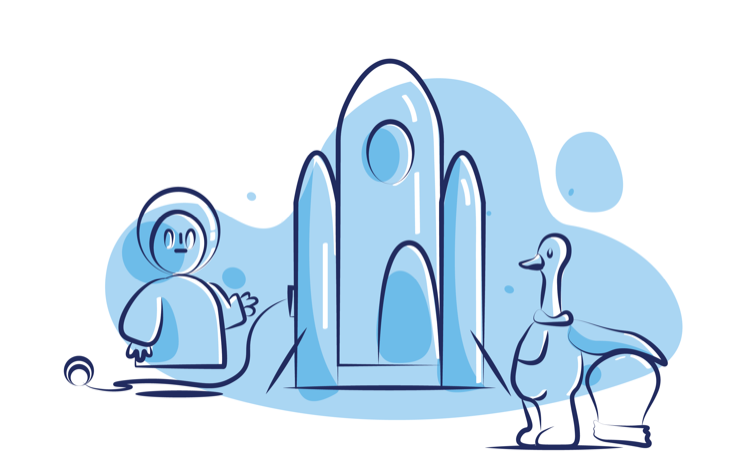Sure, there is the belief you are doing things right and your idea is the next big one. But the fear of failure is always there on the background of consciousness.
As the team that has acquired experience of cooperation with startups and helping them at all the development stages from planning to launch and maintenance, we know how to do it right.
In this article, we share the experience of facing the startup challenges to warn you of possible fuckups and suggest the ways they can be avoided.
There are few startup issues that possibly lead to a great idea failure and the methods not to get to the traps.
Case 1. Product doesn’t meet the market needs

The successful startup works on a large enough problem that they could serve with a scalable solution. The startup must solve a pain point of the target audience. If it does so, it takes off. If not, well, then there is an issue.
The reason many startups lose a chance for success at the very beginning is often the lack of understanding of the market and what is needed right now.
How can we understand, what will actually hit the town? Sure, market research and communication with the user are required.
Market research determines the size and trends of the potential target market, provides the team with information about the competition and user needs.
Communication with the user is the thing of great value when it comes to designing the product and tuning it. On the stage of initial solution building and development, it gives the product user’s profile.
It tells who they are, all about their age, marital status, habits and experience, conditions under which they may apply the solution you offered them.
Knowing all these details gives you an opportunity to define what your project will actually look like, for which platform it should be developed, which colors and special features should be implemented.
Even more, market analytics is needed as the way to make sure your project is able to compete.
Despite the platitudes that startups shouldn’t pay attention to the competition, the reality is that once an idea gets hot or gets market validation, there may be many entrants in a space.
To be competitive product must be functional and user-friendly, easy to play with. If it is harder to use than the one competitors offer, no matter how you care of the user and how unique the product you offer is, you are still out of the competition.
Research results in understanding if your product is convenient enough and lives up to the user’s expectations in every way it must. After all, the user is the one who defines your success.
Case 2. Financial issues: funding, pricing, and spendings

The other reason many startups fail lies in a financial field. Startups, the same as many other businesses, should be cost-effective and protected in any possible way.
Financial breakdown is often predictable if investor’s interest is not that high.
A number of startup founders explicitly cited a lack of investor interest either at the seed follow-on stage or at all.
Among the reasons investors possibly will not spend money on the project there are few especially common:
- They don’t trust you.
People are invested, not ideas themselves. If the investor can’t trust your character, judgments, or leadership skills, then you won’t get the necessary help. By the way, the help is what you really need.
Startupers often think they are in search of money but what they really seek is expertise and support. This is how the investments are structured. Startup founders who have the background and strong potential are taken. Then the investor comes in with the money and network and helps to bring leverage.
- You haven’t clearly defined the issue you are solving.
The first and most important thing investors need is understanding of the idea. They don’t invest in anything they don’t understand.
Your pitch should tell what the problem is, why anyone would pay for the solution of this problem, who is already working to solve this problem today (if there is anyone), why you are the right person to solve it, and what is preventing you from solving it. Nobody wants to be engaged in empty talks.
- You deeply lack the expertise.
You don’t understand properly what you are talking about. You seem not to be familiar with the market sector you are involved in or have little knowledge about it.
You really need to have at least some experience of work in the related area so that the investor could see you have expertise, knowledge relevant to the issues you are going to work with.
Lifehack is knowing the figures well, or else investor may assume the project is not calculated properly.
- You have only a phantom of an idea to present.
Your imagination is a great thing when you produce ideas. But when it comes to the actual presentation of the future product bright description is never enough.
Investors evaluate the idea by its visuals.
Your task is to prepare something inspiring and trustworthy, something to make these people believe.
A good idea is building the prototype of the product. For example, a prototype can be the basis for your idea. Also, great idea convincing investors in your idea is building the real product.
In case the budget allows it would make sense to begin with the creation of the product that contains only the most necessary options (usually it is called minimum viable product).
Unfortunately, not many startup owners understand the profits of making MVP for their business.
Case 3. Reluctance to start with MVP

“Lean” startup methodology acquired great popularity last years and has proved its efficiency.
Actually, the lean startup method suggests building MVP – startup product designed according to the needs of early users, considering only the basic features that are especially of value for launching product.
Lean startup main idea is the shortening of development cycles, reduce of the risks and expenses in order to engage the users, get useful feedback and start getting profit as soon as possible.
An important thing to understand is that MVP is not just primitive product lack of features created just to start earning at least something. MVP is a fully-valid product with an opportunity to scale.
Looking closer at the reasons to turn to lean startup strategy we can call the next ones:
- Saves development costs and time.
As a startup is a project with a strictly limited budget, it is necessary to invest money sensibly.
Each feature to implement is the hours of work and additional costs. Also, developing the full product takes a huge amount of time without any guarantee it will actually pay back.
To save resources you may need for future development or even another project, you had better cautiously choose options for your MVP.
- Allows testing the project.
The startup is a young business, so as in any business one of the main aims here is getting some profit.
Even if the idea seems to be good and business model promising, building MVP and testing it on the real market is a great way to check the project.
Sometimes the product that seems to be able to take off can, in fact, be easily replaced by some else of the same category or just be not interesting for users.
Moreover, engaging your first users by MVP is beneficial for your future business development. When you finally get the established product it will already have an audience.
- Get feedback.
To save your time and create the product that is great you definitely need the feedback from the user. Once again, a startup task is solving users’ problem.
From user experience you can find out what was done well, what was not that good, which features are useful and expected and which are unwanted.
So, why not to provide users with a lean product and use the feedback they give to develop your perfect product.
Case 4. Wrong team choice and management

No matter how strong the idea is, its success always depends on the quality of its realization.
It means, the fate of the project is in hands of your team and determined by your skills of choosing the team and managing it.
When you hire people to work on your product, it is important to understand who you are looking for. Once you find them, you have to define how to organize the process. It must be remembered that you do not build the team for startup, you build a solid team for your future strong business.
The basic principles of hiring and managing great startup team are the next:
- Professionals, learners, and action-takers.
Think well of who you are hiring. When it comes to launching a new business, personality really matters.
Your task, as a leader, is to find people to fit perfectly into your vision of the team.
Look for professionals – try to find the people that are smarter than you, especially in their professional area. As the budget may be tight, think of not the full-time specialists, but maybe you will find some consultants to contribute to your business.
Search for people who are striving to learn more and implement what they have already learned. Moreover, try to find the people you enjoy communicating with.
They are not necessarily your friends, you can stay in purely business field, but working with people you like and trust, with those who can share your ideas never wears you out and can be a great support in difficult times.
- Goals settling and communication.
Once you decided to start your own business, you are the manager of your team. To make it work successfully, you should point out where everything goes and make sure all the team members row in the same direction.
Your task is to be a signal caller – set the vision and keep the passion for getting there. Communication is vital for success.
Let your team share the information on their tasks, put forward new ideas and suggestions and don’t forget about organizing workflow with reports from the team and from you as a leader.
- Think of your company culture.
Even if your startup is just about to settle up, it is already the community to bring something worthy to the world. Think of your goals and values, and decide which of them must be shared by your team members and understood as the core of your business mission.
Team building activities are often neglected by young businesses, which is not good. They are essential to work out company culture and establish communication inside the team.
As we think of hiring a team to design and develop the product, there may be the other issue to consider – what option is the best fit for your project, freelancer or company?
The answer is the choice strongly depends on the project itself, every option has both advantages and drawbacks.
Freelancer | Company |
Saves money | More expensive |
Has expertise in a specific area | Multifunctional |
No guarantees | Reliable |
Do not care about the project | Feels responsibility for the quality of the project |
Short time association | Longtime association |
No support | Supports the project after the completion |
As we can see, a freelancer is a good option for short-term little projects, but when it comes to building big product able to scale company is more reliable and satisfactory choice.
After all, the company ready to support you can be great completion for your team.
A startup is an ideal combination of an awesome idea, great fun, and hard work. And as a team, we are ready to help you, because we believe in your idea success and ready to share with you both fun and work.










